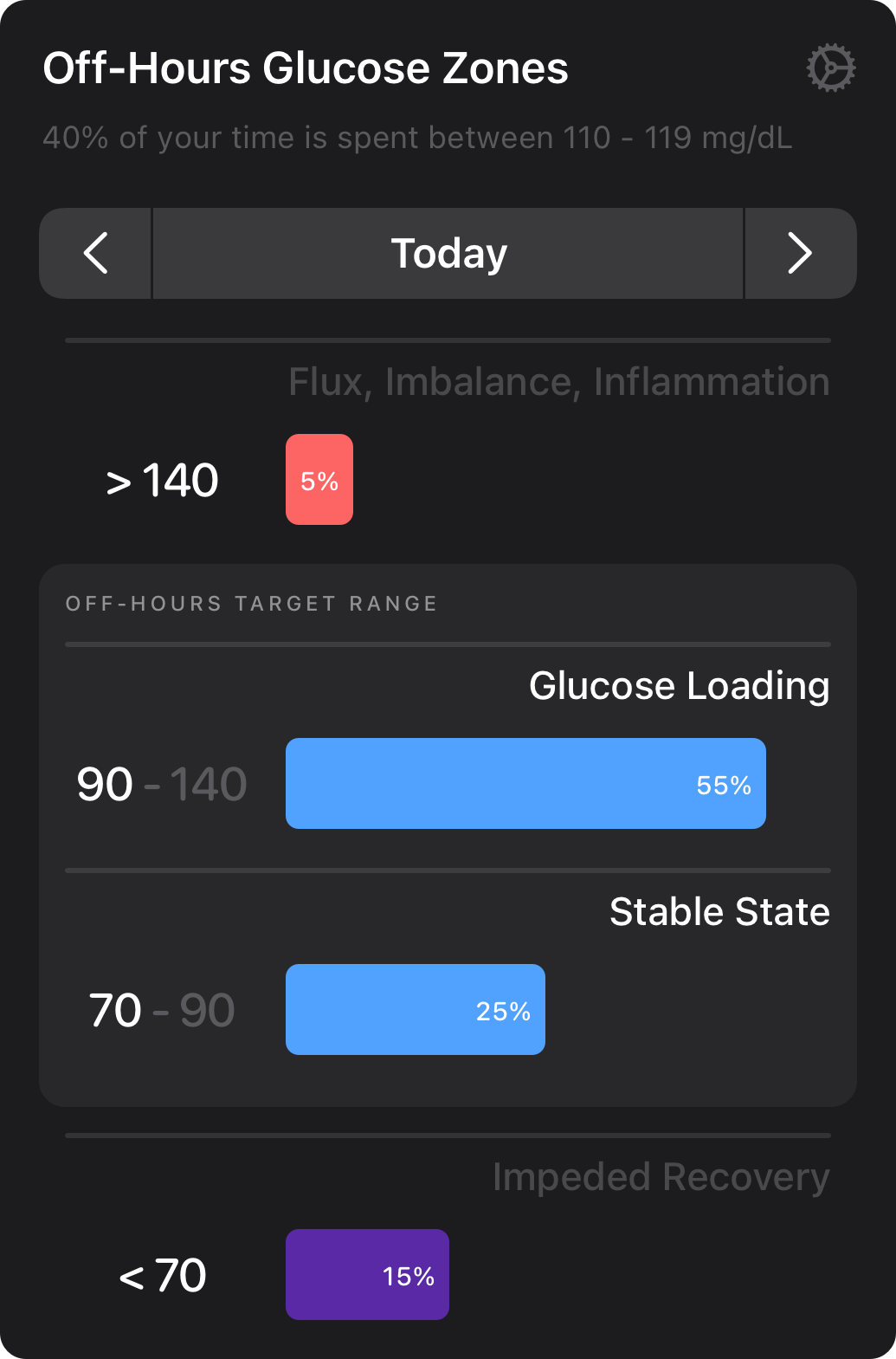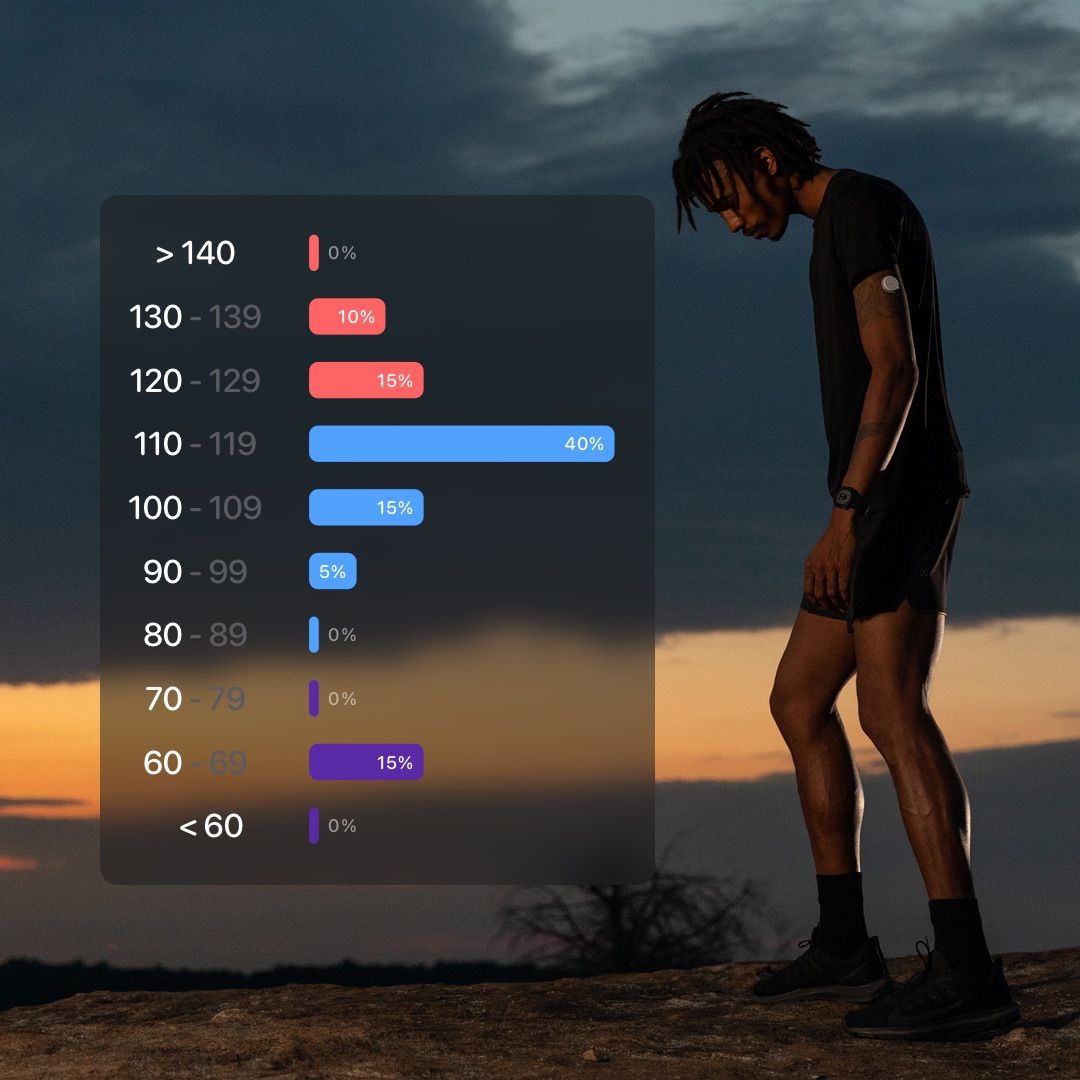We think about maximising athletic performance in two categories: On-Hours and Off-Hours.
On-Hours = training or performance. Off-Hours = recovery and preparation.
In this article, we'll discuss:
- What are Off-Hours Glucose Zones?
- How can I use my zones to help reduce inflammation?
- How can I use my zones to support carb loading before competition?
- How can I use my zones to support glycogen replenishment and recover faster?
What are Off-Hours Glucose Zones?
Good question.
Off-Hours Glucose Zones is our key insight to use to discover your optimal fuel ranges. To recover, prepare, and optimise your training. Your optimal fuel ranges will vary based on your individual body, the type of activity, and the type of adaptation you are seeking. So this is a key science that is specific to you and you alone.

Inflammation (140+ mg/dL)
When your glucose levels rise above 140 mg/dL, your body is likely to produce a significant amount of insulin in order to attempt to regulate your glucose levels down to a more manageable level. The rate of insulin secretion peaks between 140 to 180 mg/dL causing abrupt perturbations in your metabolic homeostasis.
The incidence and duration of such glycemic events (> 140 mg/dL) might expose your body to long term health-related consequences like lipogenesis, chronic inflammation, insulin resistance. Over time, this can turn your body into a chronic “storage mode” with potential side effects on body weight control and metabolic control.
Before exercising, insulin secretion induced by a glucose spike (>140 mg/dL) might impede the ability of your body to rely on fat as a fuel during exercise and therefore impacts the adaptations you seek for in that specific training session.
Glucose Loading (90-140 mg/dL)
Glucose intake has a primary role both before and after exercise. Before exercise, glucose serves as the main energy nutrient or “fuel” to #1) maximise muscle and liver glycogen stores, #2) provide glucose for intestinal absorption during exercise and #3) supply almost all of the energy in the transition from rest to moderate or intense exercise.
After exercise, quickly consuming carbs will restore depleted glycogen reserves. In fact, due to the strong relationship between replenishment of liver and skeletal muscle glycogen stores with subsequent exercise tolerance, the main factor determining recovery time is the rate of glycogen repletion.
So when you’re preparing for or recovering from a high intensity exercise, it’s helpful to up your carb consumption. The key is to fill up your muscle and liver glycogen stores.
As you increase your carb load, your average glucose is likely to trend upwards. Glucose loading, the term we use for increasing your baseline glucose with carb loading, aims to help increase the supply of glucose and glycogen in your system in preparation for these workout sessions.
Adaptive State (70-90 mg/dL)
During resting conditions, while your glucose levels hover between 70 and 100 mg/dL, your body uses a mix of homeostatic mechanisms to control and maintain such a resting stable glucose level.
Within resting conditions, metabolic perturbations (driven by any factor that would impact your glucose level and by the hormones secreted to control such changes) are minimised and your body changes its “metabolic tone” toward a more catabolic condition where utilisation predominates on storage.
Impaired Recovery (<70 mg/dL)
Watch out: When your glucose levels drop toward hypoglycaemia (around 70 mg/dL), your muscles may not receive the glucose flux required to either prepare, perform and recover for and from training. No good.
When recovering from a high intensity workout or long-sustained training, make sure to keep your glucose levels above 70 mg/dL after exercise. This is to make sure your body has adequate glucose availability. You can quickly and effectively replenish glycogen stores used during exercise.
During moderate to high intensity exercises, or when your aim is to hit peak performance in competition, make sure you get a proper glucose flux to your muscles. This optimizes metabolic efficiency and gives you ready-to-consume fuel to those working muscles. And while you’re in it, avoid dipping below 70 to ensure adequate glucose availability.
As your glucose levels trend lower and lower, your cognitive and coordinative abilities (like balance and stability) may be impaired. Studies showed how episodes of hypoglycemia lead to impaired judgment, cognitive decline, difficulty in focus and mental weaknesses. Precision and accuracy in complex motor tasks are also impaired. Not a great state for ultimate performance. Do your best to avoid dipping below < 70mg/dL to make sure you’re always at your best.
References
- Frayn K.N., 2013. Metabolic Regulation: A Human Perspective, 3rd Edition, 2013. Wiley.
- Jeukendrup, A. E., Raben, A., Gijsen, A., Stegen, J. H. C. H., Brouns, F., Saris, W. H. M., & Wagenmakers, A. J. M. (1999). Glucose kinetics during prolonged exercise in highly trained human subjects: Effect of glucose ingestion. Journal of Physiology, 515(2), 579–589.
- Nybo, L. (2003). CNS fatigue and prolonged exercise: Effect of glucose supplementation. Medicine and Science in Sports and Exercise, 35(4), 589–594.
- Spriet, L. L. (2019). Performance Nutrition for Athletes. Sports Medicine, 49(s1), 1–2.
- Gonzalez, J. T., Fuchs, C. J., Betts, J. A., & van Loon, L. J. C. (2017). Glucose plus fructose ingestion for post‐exercise recovery—greater than the sum of its parts? Nutrients, 9(4), 1–15.
- González-Rodríguez, M., Pazos-Couselo, M., García-López, J. M., Rodríguez-Segade, S., Rodríguez-García, J., Túñez-Bastida, C., & Gude, F. (2019). Postprandial glycemic response in a non-diabetic adult population: the effect of nutrients is different between men and women. Nutrition & Metabolism, 16(1), 46.
